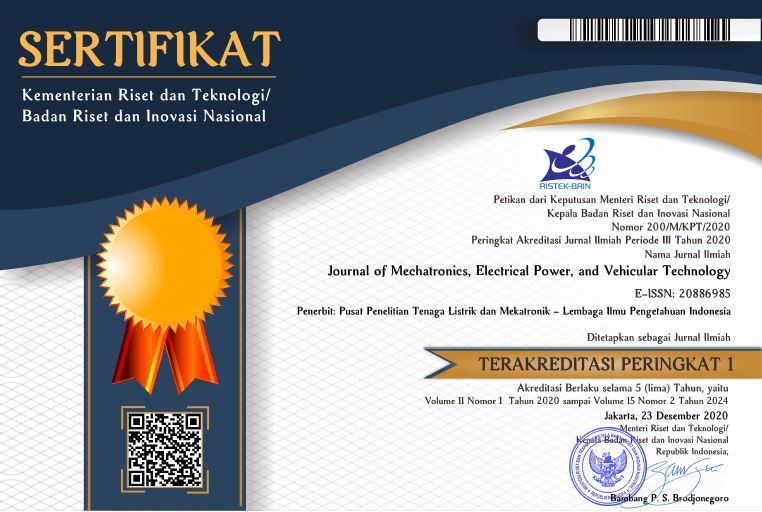Design and implementation of capacitor array as DC converters for electrical lighting in limited area
Abstract
The widely used DC-DC converters are inductor-based DC-DC converters and inductors along with combustion. The use of inductors can lead to large power losses, as well as heavy components in real terms. The proposed converter warning array aims to increase the voltage with a large increase ratio through a switching configuration process. This switching method is very simple and uses two pulses that are opposite each other so that the array converter can work optimally, whose function is to adjust the arrangement in a parallel arrangement to a series arrangement. The advantage of using a device is that it makes DC-based DC conversion lightweight and easy to implement. Tests have been carried out on 5 hanger arrays with a power of 80 W and 65 W, and the data from the test results show that the voltage increase ratio reaches 81.5 % or 4.08 times the input voltage, which indicates that the array converter warning is able to increase the input voltage according to the number of the arrays.
Keywords
Full Text:
PDFReferences
M. R. Banaei and H. A. F. Bonab, “A High Efficiency Nonisolated Buck-Boost Converter Based on ZETA Converter,” IEEE Trans. Ind. Electron., vol. 67, no. 3, pp. 1991–1998, 2020, doi: 10.1109/TIE.2019.2902785.
A. Alzahrani, M. Ferdowsi, and P. Shamsi, “A family of scalable non-isolated interleaved DC-DC boost converters with voltage multiplier cells,” IEEE Access, vol. 7, no. c, pp. 11707–11721, 2019, doi: 10.1109/ACCESS.2019.2891625.
X. Weng et al., “Comprehensive comparison and analysis of non‐inverting buck boost and conventional buck boost converters,” J. Eng., vol. 2019, no. 16, pp. 3030–3034, 2019, doi: 10.1049/joe.2018.8373.
K. Nathan, S. Ghosh, Y. Siwakoti, and T. Long, “A New DC-DC Converter for Photovoltaic Systems: Coupled-Inductors Combined Cuk-SEPIC Converter,” IEEE Trans. Energy Convers., vol. 34, no. 1, pp. 191–201, 2019, doi: 10.1109/TEC.2018.2876454.
P. Alavi, P. Mohseni, E. Babaei, and V. Marzang, “An ultra-high step-up dc-dc converter with extendable voltage gain and soft-switching capability,” IEEE Trans. Ind. Electron., vol. 67, no. 11, pp. 9238–9250, 2020, doi: 10.1109/TIE.2019.2952821.
S. Chen et al., “Research on topology of the high step-up boost converter with coupled inductor,” IEEE Trans. Power Electron., vol. 34, no. 11, pp. 10733–10745, 2019, doi: 10.1109/TPEL.2019.2897871.
S. Pourjafar, F. Sedaghati, H. Shayeghi, and M. Maalandish, “High step-up DC-DC converter with coupled inductor suitable for renewable applications,” IET Power Electron., vol. 12, no. 1, pp. 92–101, 2019, doi: 10.1049/iet-pel.2018.5414.
A. Jaya, F. D. Murdianto, E. Purwanto, and A. Rachmatdianto, “Ultra step up converter using fuzzy sugeno on HVDC application,” Proc. ICAITI 2019 - 2nd Int. Conf. Appl. Inf. Technol. Innov. Explor. Futur. Technol. Appl. Inf. Technol. Innov., pp. 82–87, 2019, doi: 10.1109/ICAITI48442.2019.8982157.
S. G. Sani, “Design and implementation of a new high step ‐ up DC ‐ DC converter for renewable applications,” no. December 2018, pp. 1–19, 2019, doi: 10.1002/cta.2593.
P. Mohseni, S. H. Hosseini, M. Maalandish, and M. Sabahi, “Ultra-high step-up two-input DC-DC converter with lower switching losses,” IET Power Electron., vol. 12, no. 9, pp. 2201–2213, 2019, doi: 10.1049/iet-pel.2018.5924.
T. Jalilzadeh, N. Rostami, E. Babaei, and M. Maalandish, “Ultra-step-up DC-DC converter with lowvoltage stress on devices,” IET Power Electron., vol. 12, no. 3, pp. 345–357, 2019, doi: 10.1049/iet-pel.2018.5356.
V. Marzang, S. H. Hosseini, N. Rostami, P. Alavi, P. Mohseni, and S. M. Hashemzadeh, “A High Step-Up Nonisolated DC-DC Converter with Flexible Voltage Gain,” IEEE Trans. Power Electron., vol. 35, no. 10, pp. 10489–10500, 2020, doi: 10.1109/TPEL.2020.2976829.
M. Meraj, M. S. Bhaskar, A. Iqbal, N. Al-Emadi, and S. Rahman, “Interleaved Multilevel Boost Converter with Minimal Voltage Multiplier Components for High-Voltage Step-Up Applications,” IEEE Trans. Power Electron., vol. 35, no. 12, pp. 12816–12833, 2020, doi: 10.1109/TPEL.2020.2992602.
D. Characteristics, “Switched Capacitor DC-DC Converters : A Survey on the Main Topologies, Design Characteristic, and Applications,” Electr. Eng., 2021, doi: 10.3390/en14082231.
N. V. Kurdkandi, “Design and analysis of a switched-capacitor DC-DC converter with variable conversion ratio,” no. June, 2020, doi: 10.1002/cta.2849.
Y. Sato, S. Member, M. Uno, and H. Nagata, “Nonisolated Multiport Converters Based on Integration of PWM Converter and Phase-Shift Switched Capacitor Converter,” vol. 8993, no. c, 2019, doi: 10.1109/TPEL.2019.2912550.
S. Singirikonda and Y. P. Obulesu, “Active cell voltage balancing of Electric vehicle batteries by using an optimized switched capacitor strategy,” J. Energy Storage, vol. 38, no. March, p. 102521, 2021, doi: 10.1016/j.est.2021.102521.
S. Folmer and R. Stala, “DC-DC High Voltage Gain Switched Capacitor Converter With Multilevel Output Voltage and Zero-Voltage Switching,” vol. 9, 2021.
A. Janabi, S. Member, B. Wang, and S. Member, “Switched-Capacitor Voltage Boost Converter for Electric and Hybrid Electric Vehicle Drives,” IEEE Trans. Power Electron., vol. PP, no. c, p. 1, 2019, doi: 10.1109/TPEL.2019.2949574.
M. Maalandish, S. H. Hosseini, and T. Jalilzadeh, “High step-up dc / dc converter using switch- capacitor techniques and lower losses for renewable energy applications,” pp. 1–12, 2018, doi: 10.1049/iet-pel.2017.0752.
Article Metrics
Metrics powered by PLOS ALM
Refbacks
- There are currently no refbacks.
Copyright (c) 2023 Journal of Mechatronics, Electrical Power, and Vehicular Technology

This work is licensed under a Creative Commons Attribution-NonCommercial-ShareAlike 4.0 International License.
Cited-By
1. Efficient Quantum-Enhanced Ensemble Fault Detection for Solar Energy Integration using an Iterative Game-Theoretic Approach with Adaptive Neuro-Fuzzy Inference and Energy Storage
Shreyas Hole
Solar Energy and Sustainable Development first page: 279 year: 2025
doi: 10.51646/jsesd.v14i1.489














